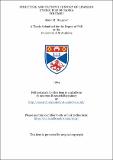Files in this item
Structure and tectonic history of Lewisian gneiss, Isle of Barra
Item metadata
| dc.contributor.author | Hopgood, Alaric M. | |
| dc.coverage.spatial | 2v. [249 p. , 108 p.] | en_US |
| dc.date.accessioned | 2018-07-18T15:27:57Z | |
| dc.date.available | 2018-07-18T15:27:57Z | |
| dc.date.issued | 1964 | |
| dc.identifier.uri | https://hdl.handle.net/10023/15547 | |
| dc.description.abstract | The Lewisian of Barra has been found to comprise foliated orthogeneisses ranging; in composition from basic amphibolites, pyroxene and hornblende granulites and intermediate amphibole-bearing quartzo-feldspathic rooks to more acid gneisses of dioritic and granitic composition. It includes some inter-foliated acid rocks which may be paragneisses. The whole complex is cut by the Hebridean Thrust and the petrography of some strongly magnetic gneisses associated with the Thrust belt has also been described. The gneisses were intruded at an early stage by basic dykes, represented by rooks ranging from amphibolites to pyroxene granulite in composition. Cross-cutting relationships between Lewisian dykes and rectilinear quartzo-feldspathic pegmatite veins consider to have been injected along axial planes of folds are used to relate the phases of dyke instrusion and migmatization to the overall tootonic sequence. Structural analysis has been carried out on planner and linear fabric date recorded on a base map on the scale of 1:0, 560, from thin section and also from the attitudes of structural elements recorded from selected localities in which the structure is particularly well exposed. Data recorded on the map have been considered separately from the following areas; the total area mapped; areas on each side of the main Thrust outcrop; areas exposing large scale structures; several small areas defined by an arbitrarily located grid to the west of the main thrust outcrop. Form the results of the structural analysis and from consideration of structural relationship in the field a tectonic sequence has been determined. The first recognizable event after the formation of the original banding was the development of isoclinal folding, followed by regional metamorphism in the amphibolites facies and succeeded in turn by the emplacement of basic to intermediate intrusions. Three successive phases of intrusion hive been recognized here. Next, folding took place on axes now trending at 30°followed by boudinage and agmatite formation and three further phases of basic intrusions. Part of the overthrust sheet exposed on the east coast was then subjected to regional metamorphism up to pyroxene granulite grade. Movement on the Hebridean thrust probably began soon after this, end asymmetrical folding about axes now plunging to 350 °established the present general orientation of the foliation and produced axial planar traces which trend south-east. The gneisses were then folded about sub-horizontal axes trending at to 150°, prior to strong folding about sub-horizontal axes trending at 100 °which resulted in the present dominant fold pattern. Finally, very open folding took place about 60 °trending axes. Except during the last fold period, migmatization was associated with all the folding and followed by pegmatite injection parallel to fold axial planes. Style has not been found to be a reliable guide to the chronological classification of folds. Open signoidal tension gashes related to the thrusting indicate that this movement continued after the final folding, and show the trusting to have beta directed to the west at an angle of elevation of between 5°and 10°, A comparison on has been wade between the structure of this area and that discussed in some published work on the Lewisian elsewhere in the Outer Isles and the Scottish Mainland. The petrogrphy and metamorphism of six phases of Lewisian dyke intrusives have been studied, and various possible mechanisms to account for dyke reorientation by sheer have boon examined in conjunction with the field relationships of these bodies. It is concluded that the intrusives have not been substantially reorientated with respect to the foliation since their emplacement a discussion is presented on the effects of ana texis on basic, intermediate and acid, gneisses, on the employment of quartzo-feldspathic pegmatite veins, and on the formation of boudinage and agmatite. Three relative ages of pegmatites have been distinguished early coarse quartzo-feldspathic pegmatites with dark feldspars, later pink quartzo-feldspathic pegmatites and late white quartzosc pegmatites. | en_US |
| dc.language.iso | en | en_US |
| dc.publisher | University of St Andrews | |
| dc.subject.lcc | QE264.B2H5 | |
| dc.subject.lcsh | Geology--Scotland--Highlands | en |
| dc.title | Structure and tectonic history of Lewisian gneiss, Isle of Barra | en_US |
| dc.type | Thesis | en_US |
| dc.type.qualificationlevel | Doctoral | en_US |
| dc.type.qualificationname | PhD Doctor of Philosophy | en_US |
| dc.publisher.institution | The University of St Andrews | en_US |
This item appears in the following Collection(s)
Items in the St Andrews Research Repository are protected by copyright, with all rights reserved, unless otherwise indicated.

